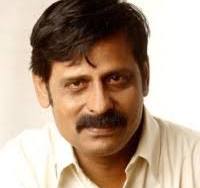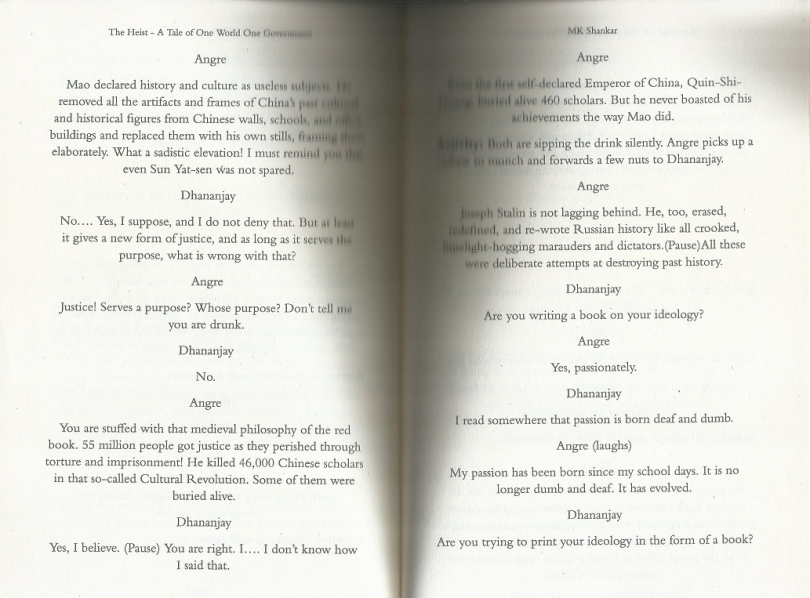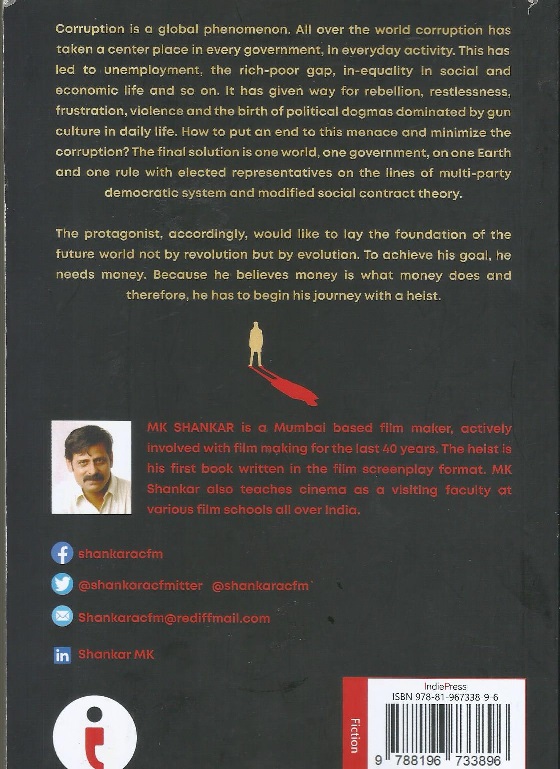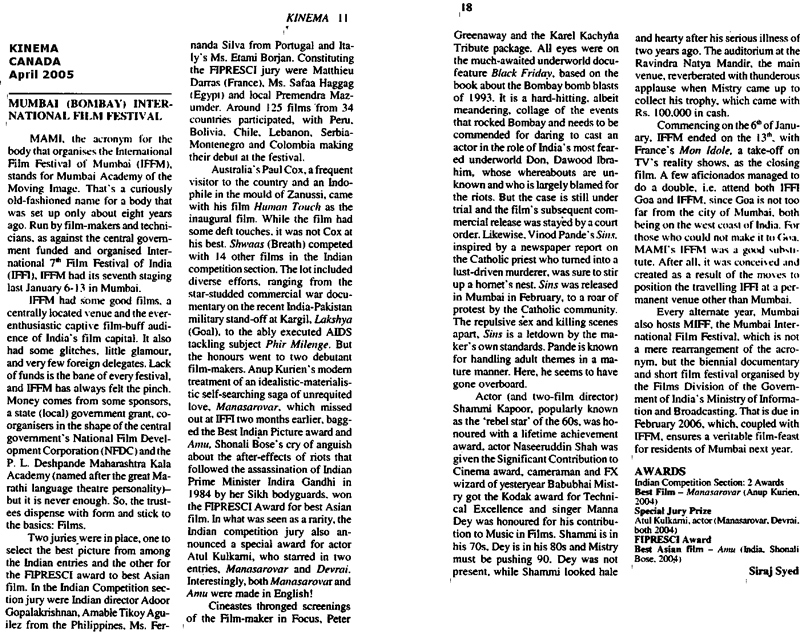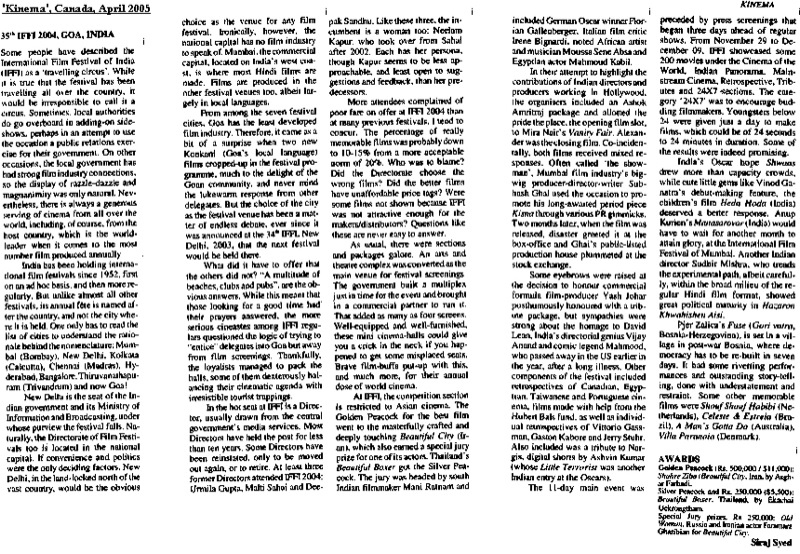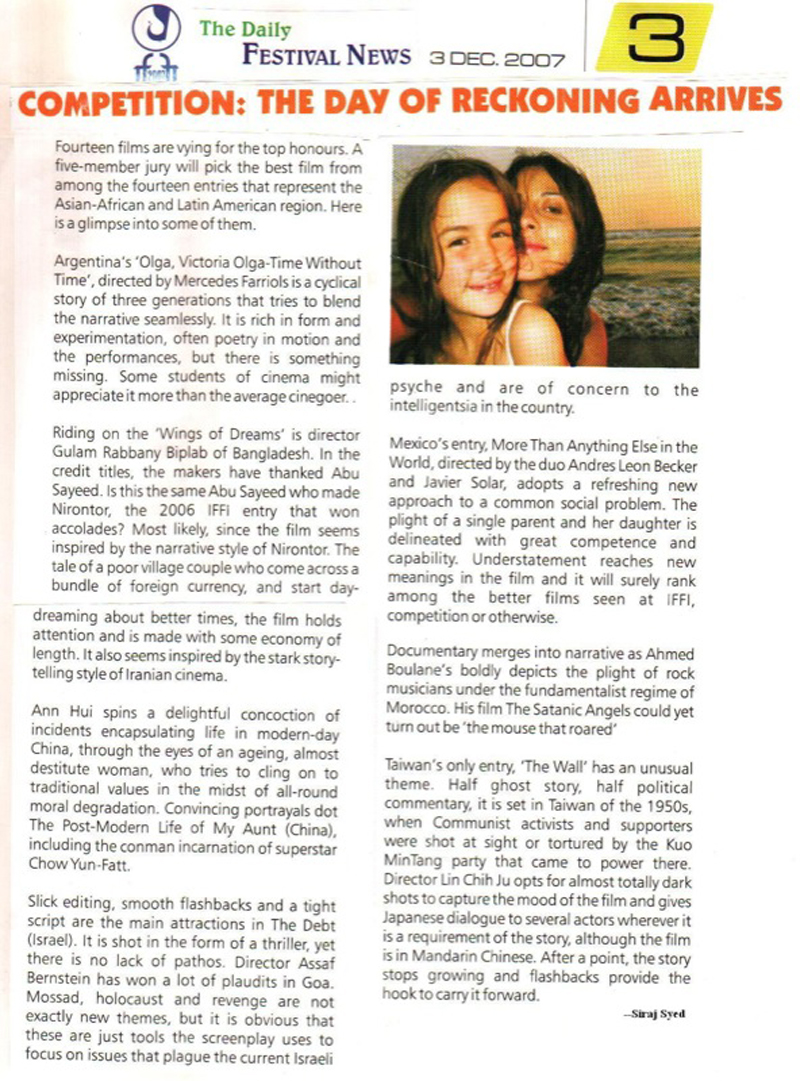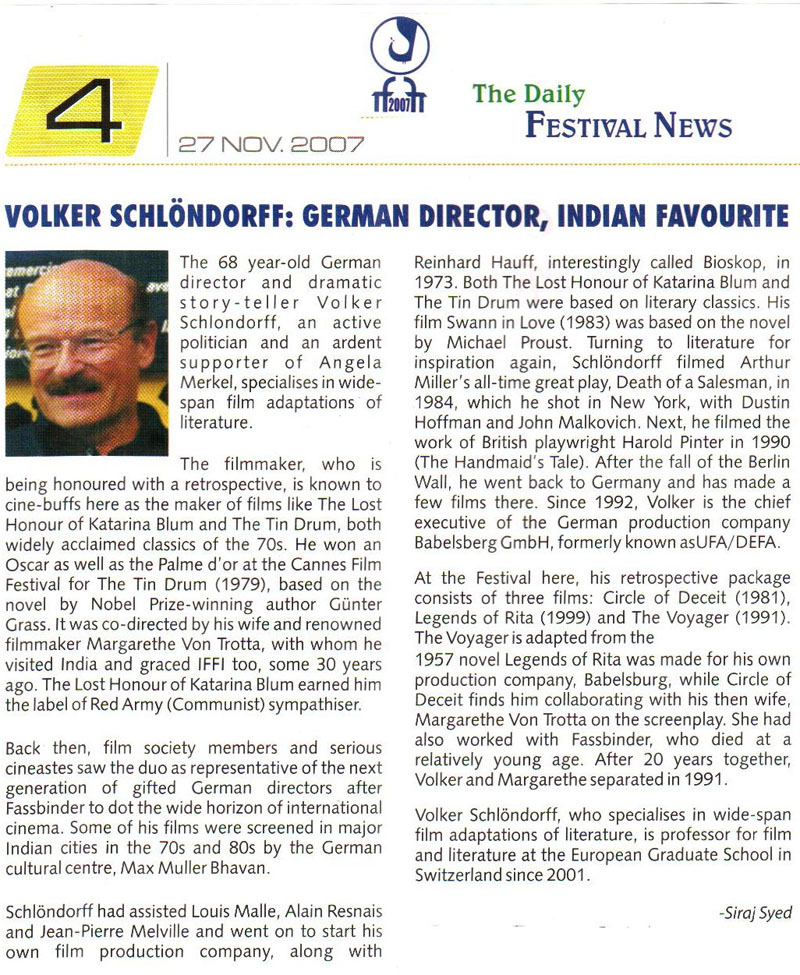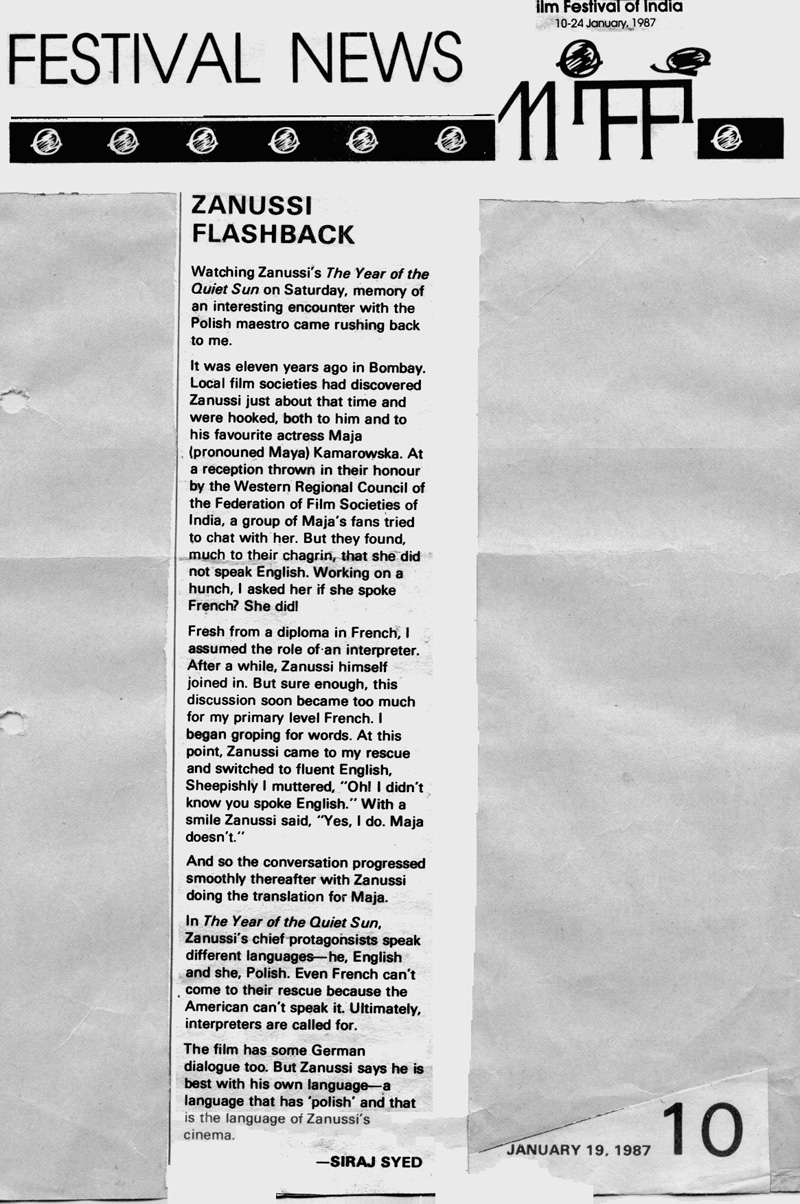|
|
||
|
Pro Tools
FILMFESTIVALS | 24/7 world wide coverageWelcome ! Enjoy the best of both worlds: Film & Festival News, exploring the best of the film festivals community. Launched in 1995, relentlessly connecting films to festivals, documenting and promoting festivals worldwide. Working on an upgrade soon. For collaboration, editorial contributions, or publicity, please send us an email here. User login |
The Heist, by M.K. Shankar: Screenplay-dialogue book review
The Heist, by M.K. Shankar: Screenplay-dialogue book review Not many directors/writers publish the screenplay of a film they could not, or did not, make. So, it was surprising when M.K. Shankar, who I first met some 33 years ago, presented me a copy of The Heist, recently. The screenplay of The Heist-One World One Government, is not to be confused with The Heist, a 2024 Hindi-language crime thriller film, directed by Aditya Awandhe, starring Nad Sham, Suman Rao and Siddhanth Kapoor. The screenplay of The Heist, the book, which includes the guiding dialogue, has been published by Indie Press, Bengaluru, edited by Ridham Bassi, and carries a price tag of Rs. 499, which is not too far away from the price of a ticket in a posh multiplex. On Amazon, the Kindle version is accessible for Rs. 199. That is on par with a low budget movie ticket. Shankar made a small budget film, Bhediyon Ka Samooh (A Pack of Wolves), in 1991. It had no stars, and I am not sure whether it made too much money at the box office, in the pre-multiplex era. Shivaji Satam, known for his role as Assistant Commissioner of Police, Pradyuman, in the long-running TV series CID, was the lead actor. The subject was corruption in the Customs Department. The Heist is about the Naxalite movement in India and the ambition of a COBRA task force Commander, Dhananjay, to establish one world, multi-party system, one government, beginning with a heist of Naxalite funds to fund its launch, aided by a senior Naxalite cadre, Angre. Naxalites are a group of rebels, mainly Adivasis (mountain and jungle dwellers, who are a constant thorn in the side of the Indian government). Almost every day, there is some encounter between the police and the Naxalites, so named because the movement began in a place called Naxalbari, in the east of India. Naxalites are present in many Indian states, centred around the angular line that connects Maharashtra and W. Bengal. Late Kanu Sanyal was its most prominent face. They are ruthless and revel in the killing of India’s para-military force, attacks that then lead to repercussions from the law enforcers. Since these rebels are technically Indian citizens, repercussions on them are not at the War (army) level, but confined to ground action against them (police and para-military forces). There are moles on both sides of the divide, and these moles give leads, which end in skirmishes.
Shankar introduces the screenplay on the book cover as follows: “Corruption is a global phenomenon. All over the world corruption has taken a center-place in every government, in everyday activity. This has led to unemployment, rich-poor gap, in-equality in social and economic life and so on. It has given way for rebellion, restlessness, frustration, violence and the birth of political dogmas dominated by gun culture in daily life. How to put an end to this menace and minimise the corruption? The final solution is one world, one government, on one Earth and one rule with elected representatives on the lines of multi-party democratic system and modified social contract theory. The protagonist, accordingly, would like to lay the foundation of the future world not by revolution but by evolution. To achieve his goal, he needs money. Because he believes money is what money does. And therefore, he has to begin his journey with a heist.” There is large dose of political ideology in the book, and many scenes between Dhananjay mad Angre, full of dialogue, discussing the merits and demerits of political cult leaders in the world, and philosophers, which might not be easily understood by the average man on the street, in India. Nevertheless, Shankar records it as a FAQ, with Angre answering and clearing Dhananjay’s queries. it shows that Shankar is very well read and has a world view that is both revolutionary and path-breaking. Here is are excerpt from an article in the Indian Express, dated 14 May 2003, written by Ajit Kumar Jha: *An assassin to a colleague: “I know that we have to kill 100 people, but I am so disgusted with slitting human throats that I have to throw up first.” *The number of police personnel killed by Naxals in the new states of Jharkhand and Chhattisgarh is even higher than those killed in Jammu and Kashmir. Left wing extremism is proving to be a serious challenge. It appears that wherever he intended to say ‘Indistinct Chatter’, the editor has substituted the words ‘Distinct Chatter’. If it were distinct chatter, then there would be dialogue. Since this chatter refers to dialogue-less scenes, such scenes are usually described in the sub-titles of films as ‘Indistinct Chatter’. And it also appears that the author has had some personal insights into the movement, going by its authenticity, or probably, has spoken to some of the personnel on either side of the divide.
To be sure, it is difficult to review such a publication, because it is not intended to be read as a book, it is a screenplay. One has to imagine how it would translate as a film. To me, it appeared to be a subject that would not attract finance easily, and if and when it is made, by the author himself, it would land Shankar in some censor trouble, on account of the strong political and, occasionally, sexual content. But there is a lot of action and shooting/killing in the ‘encounters’. COBRA represents the law of the land, while the Naxalites, including thousands/lakhs of farmers fighting for their land, against land-landlords, land grabbers, developers, money-lenders, and uppermost of all, law enforcers, who all perceive them as anti-national and regressive. In the long run, they even dream of carving out a Naxal nation, within the Indian nation. Obviously, they follow the Communist philosophy and greet each-other as Comrades, with the Laal Salaam (read Red Salute). Printing with large spaces between lines and paragraphs, it is easy reading for the eye of the reader, but also comes across as a collection of the ideologies, concepts and actions of statesmen and leaders. It is interesting and absorbing for those who have at least a basic knowledge of world politics and revolutionaries and dictators, like Mao-Tse Tung of China and Pol Pot of Cambodia. The knowledge of ignoramuses will be definitely enhanced, especially that of persons in their teens, 20s and 30s. Those in the age bracket of 30-50 will relate to it even better, while those above 50 would have had actual exposure to the movement through the media, and will find it related to context. That is the age-bracket to which Shankar himself belongs.
M. K. Shankar, who almost looks the same as he did 33 years ago, has been actively involved with film-making for the last 40 years. There have been a few films made on the subject of Naxalites, but another one, in the Shankar mould, with some of the conversations either curtailed or transposed into action on screen, and fewer flashbacks, would be welcome. The Heist is his first book, written in the film screenplay-dialogue format. Shankar teaches cinema, as a visiting faculty, at various film schools, all over India. 07.01.2025 | Siraj Syed's blog Cat. : Independent FILM
|
LinksThe Bulletin Board > The Bulletin Board Blog Following News Interview with IFTA Chairman (AFM)
Interview with Cannes Marche du Film Director
Filmfestivals.com dailies live coverage from > Live from India
Useful links for the indies: > Big files transfer
+ SUBSCRIBE to the weekly Newsletter Deals+ Special offers and discounts from filmfestivals.com Selected fun offers
> Bonus Casino
User imagesAbout Siraj Syed Syed Siraj Syed Siraj (Siraj Associates) Siraj Syed is a film-critic since 1970 and a Former President of the Freelance Film Journalists' Combine of India.He is the India Correspondent of FilmFestivals.com and a member of FIPRESCI, the international Federation of Film Critics, Munich, GermanySiraj Syed has contributed over 1,015 articles on cinema, international film festivals, conventions, exhibitions, etc., most recently, at IFFI (Goa), MIFF (Mumbai), MFF/MAMI (Mumbai) and CommunicAsia (Singapore). He often edits film festival daily bulletins.He is also an actor and a dubbing artiste. Further, he has been teaching media, acting and dubbing at over 30 institutes in India and Singapore, since 1984.View my profile Send me a message The EditorUser contributions |


















